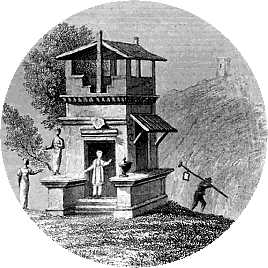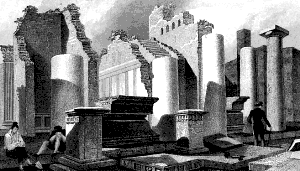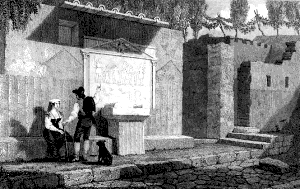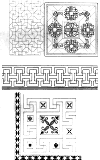Chapter III - Forum |
|
On entering the Forum from the great gate of the
chalcidicum, which opened inwards and was
fastened by two bolts into the pavement, it will be
observed that much has been effected since the
publication of the plan in the year 1818. |
These columns are placed on plinths three inches in height
and two feet five inches square, upon which are circular
bases eight inches high. The shafts, which are in part
corded, are about one foot eleven inches in diameter. The
diameter of the upper range did not exceed one foot three
inches. The intercolumniation was about five feet six, and,
within the portico, was a pedestal opposite to every pillar.
The restoration in the former Volume of Pompeiana is
defective with regard to the two ranges here, and, probably,
in other parts of the Forum. From this portico was the great
entrance into the building commonly called the
Pantheon, which will be hereafter described, and from
the upper portico it is very probable that a connexion
existed with the gallery of the same building, seemingly
accessible by no other means. The exit from the Forum on this
sicle was under a species of Triumphal Arch, exceeding its
fellow in dimensions, probably in order that its greater
distance from the Forum might have rendered them apparently
equal when viewed from the centre.
The arch offered a passage twelve feet eight inches in
breadth, and the piers were nearly of the same magnitude.
Within these has been a receptacle for water and, possibly,
some sort of fountain for rendering it useful. At the
opposite extremity of the Forum, two habitations have been
excavated near the house discovered by General Championet
during the year 1826, but, except the pavements, they appear
to have been anciently stripped of every species of
decoration, and therefore have little to recommend them to
notice. M. Bibent observes that the four columns of the house
of Championet are placed upon the pavement, and that,
consequently, they may be considered as having been
subsequently erected, and offer no argument in favour of
columns in the Cavaedium.
The opposite side of the same Street leading to the
excavation of the Regina Carolina has also been examined, but
without bringing to light any thing of importance. On
examining in certain lights portions of the painted wall
under the colonnade of the Basilica, many inscriptions may be
perceived faintly scratched with a sharp point by the idlers
of Pompeii. Some of them have been published, but without an
acknowledgement to the Author, from whose portfolio they were
furnished. They are stated to be painted on an outer wall to
the east, but it will save trouble to mention that they are
to be found on the inner or south side of the north wall.
They are not remarkable for correctness either of style or
sentiment, but among the least exceptionable are the
following.
Nemo nisi Bulius nisi qui amavit mulierem.
H. Caesari. tertio Germanico. Caesare iter.
Amianthus. Epaphra. tertius ludant cum Idysto
Jucundus Nolanus petat. NC. Restiticus.
Non est ex albo Judex patre Aegyptio.
ERWV and ALEXANDROV
VIBIVS SECVNDVS
is painted in large letters. Again, scratched with a point are in another place,
C. Pumidius Dipilus heic fuit
Ad nonas octobreis. M. Lepid. Q. Catul. Cos.
On the north wall also are,
Lucrio et Salus hic fuerunt
Damas audi
Phebus
Arescus. A. Proism nefario
Sumsit sibi casta Muthunium.
Suavis vinaria sitit roto vos et valde sitit.
There is also a libel on the reputation of a female named Lucilia :
Lucilia a corpore lucrum fecit.
Many others are to be read with difficulty, and without much improvement in morals or orthography.
|
The view, plate X., of the lower part of the shafts
of the columns which formed the peristyle of the Forum
is calculated to give an idea of the present state of
the ruins, and of the ornamented pedestals, which, when
they supported their statues, must have added so
materially to the beauty and interest of the
spot. C. CVSPIO. C. F. PANSAE II. VIR. I. D. QVART. QVINQ EX. D. D PEC. PVB |
They are all of white marble. ln front of them, other
pedestals, of more ancient date and rude construction, may be
observed, which were evidently intended to be replaced by the
more elegant models which were erecting at the moment of the
last fatal catastrophe. Bonucci conjectures that these
pedestals sustained the statues of the Scauri, Gelliani,
Holconii, and other worthies of Pompei.
That species of bench or table which is seen in the recess
behind the first column on the right in plate X. is
remarkable for containing two measures used as the standards,
probably, for grain in the market of Pompeii. The stone is a
thick horizontal slab, pierced perpendicularly by two
inverted cones truncated at the smaller end. Baskets or sacks
were placed beneath, and a flat piece of wood was held so as
to prevent the grain from running out at the bottom, till,
the measure being full, the contents, on the removal of the
wood, fell into the recipient. The smaller may be about half
the size of the larger. Bonucci mentions a stone, in the
Royal Museum at Naples, which contains measures of liquids as
well as of solids, and with the narres of the magistrates to
authenticate them. Such public measures were probably common
to all the cities of antiquity. Travellers may observe one of
these stones in a wall near the north gate of Fondi, and
another, with three different measures, on the ground near
that of Naples.
It may be necessary to observe that the great building on the
west of the Forum called the House of the Dwarfs, and the
Temple of Bacchus in the first work on Pompeii, seem now to
have acquired, universally, the name of Venus and the College
of Venerei. Bonucci says an inscription was found on the spot
which would decide the question, but he has not given it in
the original Latin. The general meaning is, that
«Marcus Holconius Rufus, Duumvir Judge for the first
time, and C. Egnatius Postumus, Duumvir Judge for the second
time, have bought, according to a decree of the Decurions,
the right to close the windows, for the sum of three thousand
sesterces, and they have also raised the private wall of the
Incorporated College of Venerei as high as the roof».
These windows, it is probable, looked toward the Forum.
On quitting the Forum, by the opening near a low door, which
is that of a prison, may be observed the figure of a goat
upon the pier of a house where milk was sold ; and, near it,
the picture of fighting gladiators, which has been roughly
represented in the preceding work, is seen upon the wall of a
house which, from its sign, and a sword which was found at
its excavation, is now commonly called the school of fencing.
Under the goat is written
M. CASELLIVM AED. DIF. FAC.
FIDELIS
The inscription under this is so ill written that it is not without difficulty decipherable. It is like the celebrated inscription in the Baths of Titus, except that Venus alone, of all the divinities of Pompeii, threatens revenge to the transgressor. The Roman inscription runs thus :
Duodecim Deos et Dianam et Jovem
Optimum Maximum habeant iratos
Quisquis, etc.
This of Pompeii is «Abiat Venere Pompeiiana iratam qui hoc laeserit». It is unnecessary to remark on the Latinity of this inscription, in which the principal word is written rather B O M P I L I A N A than as it ought to be. The protecting aedile is named MARCELLVM. The practice of rendering sacred any spot, either by painting or inscription, appears to have been common ; and Persius says, that two serpents painted upon a wall were supposed to sanctify the spot, and prevent the wilful accumulation of filth there, much as the cross or a penny print of the Madonna is vainly used in modern Naples for the same purpose. In this curious painting the two personages seem to be Tetraites and Prudens.
PRVDES. I. XIIX. TETRAITES. L. X.
This has most ingeniously been translated in the Museo Borbonico, and signifies «Prudens invincible in the eighteenth combat. Tetraites, who fell in the tenth». This sense is obtained by calling the letter I invictus and the L lapsus. They are combatants, according to this author, called Mirmillones, as may be seen by the fish on their helmets. A herald separates the combatants, and gives a wand to the victor. Near this on a pier is
MARCELLVM. ET. CELSINVM. AED.
... NO VICI CAVLO + AC
|
This street runs to the right, in the direction of the north entry of the Pantheon. To the west it is slightly curved, and, at a little distance from the Forum, may be seen an altar, probably consecrated to Jupiter, placed against the wall of a house upon the raised footpath. It is represented in plate XI, and is not without interest. It has been engraved by Mazois, to whose work a copy of the original drawing was presented by the author, but not acknowledged in the text. The eagle alone, in the painted tympanum, seems to indicate Jupiter as the presiding deity. The remains of a basso relievo in stucco are too much mutilated to be traced with precision. |
On quitting the Forum, by the triumphal arch on the east
side of the temple of Jupiter, the street, now called that of
Fortune from the temple of the goddess, presents itself,
terminated at the extremities by triumphal arches, which,
though now sufficiently lofty, were probably still more
elevated, as, before the excavation, their present summits
were on a level with the soil of the vineyard. It is possible
the statues on that of the Forum were removed after the
destruction of the city, and probable that those of the other
arch were thrown down by the earthquake, as the fragments
were found below.
The street of Fortune is one of the most spacious in Pompeii,
being 26 palms wide and nearly 200 feet long. It is flanked
by footpaths on each side ; and, besides its terminations in
triumphal arches, the portico of the temple of Fortune must
have added great dignity to its appearance. The first pier on
the right is decorated by a relievo, in terra cotta, of two
men carrying wine, which was probably sold at the house. At
this angle was an inscription with the name of Samellius, in
which the letters ID in the second fine have been taken for
the word Judex.
M. SAMELLIVM
MILIVM. MAIVM. D. V. ID
AVRELIVS. CIVEM. BONVM. FAC
PAQVVIVM. D. V. I. DO
|
Close to the pavement on this pier was a remarkably spirited griffin, on a black ground, which has now disappeared. The street running to the right from this end of the Forum has been called, on the spot, the Strada dei Frutti Secchi, from an inscription showing that dried fruits were sold in it. On the right we find a range of shops, in front of which ran a portico, or vestibule, with piers and columns. On one of these piers is the inscription A. VETTIVM AED SACCARJ. ROGshowing that even those who carried sacks were
considered as a body or corporation, and stood in need
of a patron. Nearly opposite the entrance to the
thermae, which occupies the centre of this
street on the left hand, is a house on the right of
more consequence than the rest. It has received the
name of the house of Bacchus from a large painting of
the god yet existing on a wall opposite to the
entry. |
|
In the same house is a pavement of coloured marbles,
in the nature of the opus Alexandrinum, which is
pretty, and is therefore given at the end of this work,
in plate LXXXVI. |
Many of the pilasters had inscriptions which have been
since defaced.
On the second of these Lucius Popidius the Aedile was
recorded as the protector of the house. On the third Caius
Cuspius Pansa. On the seventh
SABINVM. PANSAM. AED
SVLIODVS. ROG.
On the ninth is
CASELLIVM
AED
Q. NUMISIVM
MAIVM. AED. OR
PRISCVM.
On the fifteenth we find Pansa again, who was certainly
among the most powerful of the patrons of Pompeii, and had a
numerous list of clients.
This street seems to have been more than usually productive
in bronzes. Among other things a pretty Mercury upon a rock,
three inches high, the statue of a female nine inches high,
another Mercury four inches high, and many bronze lamps and
stands were excavated. Several vases, basins with handles,
one of which was formed by the wings of swaps, patera, bells,
an inkstand, a strigil, elastic springs, a needle, hinges or
cardines, a lock, buckles for harness, an oval
caldron, a mould for pastry, and a saucepan, contribute to
our knowledge of the common utensils of the Ancients.
Here have also been discovered no fewer than two hundred and
fifty little bottles of common glass, forty-one bottles nine
inches high, four decanters and many fluted tumblers, six
tumblers eight inches high and only two inches and two-fifths
in diameter, with thirty cups of green glass, and four plates
six inches in diameter. Besides these were found several
bottles formed of four bulbs united, twenty-six tazze, and
ten other cups. In marble was discovered a small laughing
Faun, a dise of porphyry, and a weight, used in spinning
byhand, of alabaster with its ivory axis remaining.
The list finishes with a leaden weight, forty-nine common
pottery lamps with masks and animals, forty-five lamps with
two lights, three tills, or boxes, with a slit, to keep
money, and, in these, thirteen coins of Titus, Vespasian, and
Domitian. Seven glazed plates were also dug up, which are a
great curiosity, and were found packed in straw, but which
the author did not see. Seventeen jars of terra cotta,
unvarnished, and seven dishes in the same state, with a large
pestle and mortar, complete the numerous list given in one of
the reports.
An account of scales, said to have been found about the time
of the same excavation, appeared in print at Naples. They
were of a species, according to the work, called hmizugia
stathrai, trutina Campanae, sfairwma and
aequipondium. The beam was one palm and a third long. The
weights were in the forms of an armed head, a goose's head,
etc. On the beam were numbers from X to XXXX, and V was
placed for division between two Xs, besides smaller
fractions. The inscription was
IMP. VESP. AVG. IIX
T. IMP. AVG. F. VI. C
EXACTA. IM. CAPITO
Which bas been translated, «In the Consulate VIII of
Vespasian Emperor Augustus, and in the VI of Titus Emperor
and Son of Augustus, Proved in the Capitol». This
inscription is another confirmation of the care which was
taken to produce a strict uniformity in weights and measures
throughout the empire, and the date corresponds with the year
77 of our aera, being only two years prior to the great
eruption.
A steetyard was found, also, with chains and hooks and with
numbers up to XXX. Common scales, with two cups, like those
in modern times, were found, but it is remarkable that they
are without that little projecting point above the beam which
serves to mark more accurately the absence of equipoise, and
which, according to the dissertation here quoted, was called
by the Greeks and Romans, kanwn, ligula, and
examen.
The skeleton of a Pompeian, who, apparently, for the sake of
sixty coins, a small plate, and a saucepan of silver, had
remained in bis bouse till the street was already half filled
with volcanic matter, was found as if in the act of escaping
from his window. Two others were found in the same street,
probably arrested by the vapour emitted by the sulphureous
mass.
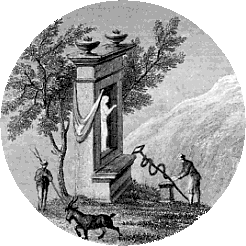
Vignette 8 - Commentary |
